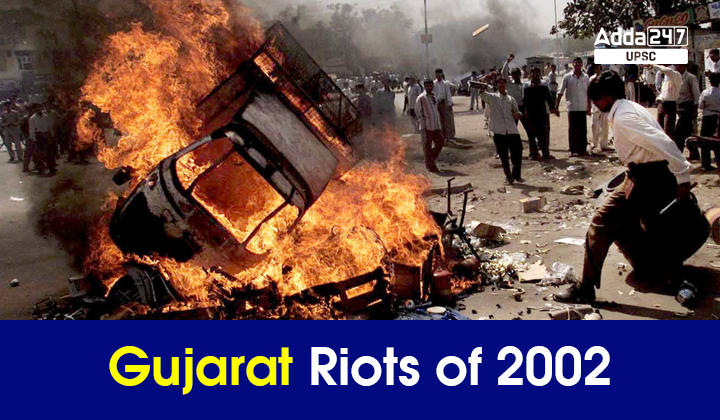Table of Contents
Gujrat Riots 2002
The Gujrat Riots of 2002 are often in the news due to recent developments and court proceedings. It is important that the students preparing for Civil Services Examination must have some idea about the Gujrat Riots of 2002. A riot is a form of civil disorder commonly characterized by a group lashing out in a violent public disturbance against authority, property, or people. Riots are generally a failure of social structures and inevitably a dent in the fabric of society. This incident is directly linked to the GS I Topics like – India Society, Communalism, and Post Independence History. Indirect connections can also be made to topics in the governance and ethics section. Here in this space candidates can know all about the Gujrat Riots 2002.
Gujrat Riots 2002: Buildup
- On the morning of February 27, 2002, a coach of the Sabarmati Express — Coach S6 was set ablaze and 59 passengers traveling in that coach were charred to death.
- Sabarmati Express was returning from – Ram Janmabhoomi.
- The train had arrived at Godhra station in Gujarat just then. The victims included 27 women and 10 children. Injuries were suffered by another 48 passengers on the train.
- Reports indicate that the coach was set ablaze near Godhra railway station by a mob consisting of individuals from the Muslim community.
- Regrettably, this horrific act resulted in the unfortunate death of 59 Hindu devotees, including children, in the train attack.
- Following this incident, riots broke out on the evening of February 2 and continued for 2-3 months across the state.
- In 2005, the Indian government provided information to the Rajya Sabha stating that the communal riots resulted in the loss of lives for 254 individuals from the Hindu community and 790 individuals from the Muslim community. Additionally, there were reports of 223 people missing. The riots also left tens of thousands of individuals displaced from their homes.
Gujrat Riots 2002: Data and Facts
According to official records, the Gujarat riots resulted in the loss of lives for a total of 262 Hindus and 863 Muslims. These numbers also take into account the casualties resulting from police firing. However, it is important to note that the actual number of casualties may be significantly higher, indicating that individuals from both religious communities were affected by the violence.
Gujrat Riots 2002: Inquiry and Commissions
Nanavati Commission: The Gujarat government, under the leadership of Chief Minister Narendra Modi, established the Nanavati Commission as a Commission of Inquiry. In its final report submitted in 2008, the commission described the train burning incident as a conspiracy.
Banerjee Commission: The UPA government formed a separate inquiry commission led by Justice UC Banerjee. In the commission’s report submitted in 2006, the incident was classified as an accident. However, the Supreme Court later deemed the report unconstitutional and invalid.
Special Investigation Team (SIT): The Supreme Court constituted a Special Investigation Team (SIT) that supported the prosecution’s charges that the incident was not an unplanned mob outrage but rather involved a conspiracy.
What lead to Gujrat Riots in 2002
There are various reasons and factors associated with the occurrence of riots. There are a few general causes that lead to massacres at this level. Here are a few factors that lead to Gujrat Riots:
- Communalism: Mass mobilization in the name of religion and using sentiments for inciting violence.
- Loss of human values and dehumanization: Riots are caused due to dehumanization and disregard for human life.
- Lack of emotional intelligence: Inability to control emotions and conscious attempts by few to negatively influence leads to violence at this scale.
- Failure of Governance- Riots are inherently law and order issues. Various committees have questioned the conduct of police officials.
Gujrat Riots 2002 and Court Proceedings
The trials for the case began more than eight years after the incident, specifically on June 1, 2009. On March 1, 2011, a special SIT court delivered its verdict, convicting 31 individuals. Among them, 11 were sentenced to death, while 20 received life imprisonment. Additionally, the court acquitted 63 people involved in the case. The SIT court agreed with the prosecution’s charges, stating that the incident was not a spontaneous act of mob violence but rather a result of a premeditated conspiracy. The 31 convicts were found guilty under relevant sections of the Indian Penal Code, including those pertaining to criminal conspiracy, murder, and attempted murder.
| Follow US | |
| UPSC Govt. Jobs UPSC Current Affairs UPSC Judiciary PCS Download Adda 247 App here to get the latest updates |



 TSPSC Group 1 Question Paper 2024, Downl...
TSPSC Group 1 Question Paper 2024, Downl...
 TSPSC Group 1 Answer key 2024 Out, Downl...
TSPSC Group 1 Answer key 2024 Out, Downl...
 UPSC Prelims 2024 Question Paper, Downlo...
UPSC Prelims 2024 Question Paper, Downlo...




